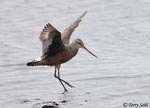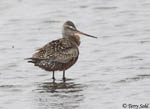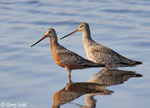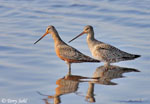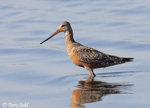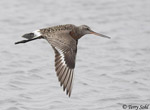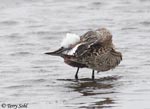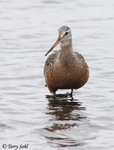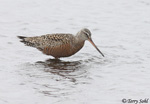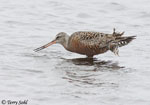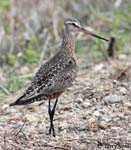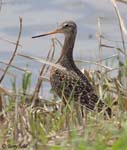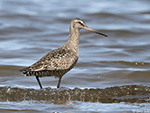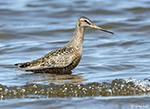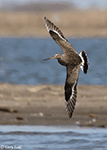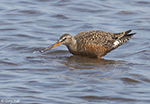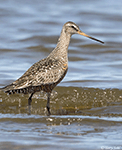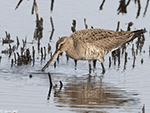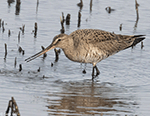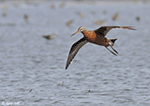| Length: 15 inches | Wingspan: 28 inches | Seasonality: Migrant |
| ID Keys: Long pink-based upcurved bill with black tip, rich chestnut below in spring migration through the state, black barring, dark legs. | ||
 Found
in South Dakota during the spring migration, the Hudsonian Godwit migrates off
the Atlantic Coast during the fall migration and is never seen in South Dakota
in that aseason. They have the typical
"Godwit bill", slightly upcurved and two-toned, with a striking black
and white pattern on their wings and tail (seen in flight) that easily
differentiate them from the Marbled Godwit, the other godwit species found in
South Dakota. Godwits may utilize deeper water when feeding than do most
other shorebirds. The Hudsonian Godwit is known as one of the world's
longest non-stop migrants, as their fall migrations evidently are non-stop from
their breeding grounds in the Arctic, to their wintering grounds in southern
South America.
Found
in South Dakota during the spring migration, the Hudsonian Godwit migrates off
the Atlantic Coast during the fall migration and is never seen in South Dakota
in that aseason. They have the typical
"Godwit bill", slightly upcurved and two-toned, with a striking black
and white pattern on their wings and tail (seen in flight) that easily
differentiate them from the Marbled Godwit, the other godwit species found in
South Dakota. Godwits may utilize deeper water when feeding than do most
other shorebirds. The Hudsonian Godwit is known as one of the world's
longest non-stop migrants, as their fall migrations evidently are non-stop from
their breeding grounds in the Arctic, to their wintering grounds in southern
South America.
Habitat:
Freshwater marshes, mudflats, flooded fields during migration. Nests on mixed tundra/wetlands in northern Canada and Alaska.
Diet:
Primarily insects inland during its migration through the state. Hudsonian Godwits will also feed on crustaceans, mollusks, and marine worms.
Behavior:
Forages in shallow water, using its long bill to probe in the mud beneath for food items.
Breeding:
Non-breeder in South Dakota. In breeding range, the nest of a Hudsonian Godwit is a shallow depression on the ground, with a sparse lining of vegetative material. The female usually lays 4 eggs, and both parents help to incubate them. When the eggs hatch, the young soon leave the nest and find their own food, but both parents help to protect them. The young fledge after about one month.
Song:
High-pitched kae-wit, or more simple single call notes.
1Click here to hear the call notes of a Hudsonian Godwit.
2Click here to hear the calls and "song" of a male Hudsonian Godwit
Migration:
Summers in northern Canada and Alaska, migrating through the center of North America in the spring. Migration south in the fall is primarily off the Atlantic coast as it makes its way to South America for the winter.
Interactive eBird map:
Click here to access an interactive eBird map of Hudsonian Godwit sightings
Similar Species:
Inside the borders of South Dakota, they are most likely to be confused with Marbled Godwit. Outside of South Dakota, they could potentially be confused with the Bar-tailed Godwit and Black-tailed Godwit.
- Marbled Godwit - Marbled Godwits share the same body shape and structure as Hudsonian Godwits, but are noticeably larger if both species are seen together. Female and winter-plumaged Hudsonian Godwits are most likely to be confused with Marbled Godwits, as they lack the rich colors underneath and have overall brownish tones that are similar to the Marbled Godwit. Other than size, the most obvious way to differentiate the species is when they take flight, when the bold black and white tail and wing patterns of a Hudsonian Godwit are dramatically different than the brownish, barred patterns on a Marbled Godwit.
- Bar-tailed Godwit - An extremely rare visitor to the interior of the United States, the Bar-tailed Godwit has not been seen in South Dakota. They are similar in structure and size to a Hudsonian Godwit, but in breeding plumage have a rich reddish neck, breast and belly and a contrasting darker brown back, while a Hudsonian Godwit has a darker ruddy color underneath with barring, and lacks the rich colors on the throat.
- Black-tailed Godwit - A species even more rare in the interior of the United States, not likely to be seen here. The rich coloring on a breeding plumaged Black-tailed Godwit is found on the neck and head, while the rich colors on a breeding-plumaged Hudsonian Godwit are on the belly.
- Long-billed Curlew - Not a godwit, but another large "shorebird" species that in South Dakota in summer is found on the grasslands. From a distance the two species could be confused. However, the Long-billed Curlew is substantially larger, is primarily found in upland habitats, and has a extremely long bill with a strong downcurve (compared to the slight upcurve on a Hudsonian Godwit).
Conservation Status:
Hudsonian Godwits were were seriously depleted in the 19th century due to hunting pressures. Populations rebounded in the 20th century, but populations have been showing signs of decline in recent decades. . However, they are still found across a relatively broad geographic area and are relatively common in parts of their range. As a result, the IUCN lists the Hudsonian Godwit as a species of "Least Concern".
Further Information:
1) USGS Patuxent Bird Identification InfoCenter, Hudsonian Godwit
2) WhatBird - Hudsonian Godwit
3) Audubon Guide - Hudsonian Godwit
Photo Information:
April 23rd, 2020 -- Lake Thompson, South Dakota -- Terry Sohl
Additional Photos:
Click on the image chips or text links below for additional, higher-resolution Hudsonian Godwit photos.
Audio File Credits:
1Garrett MacDonald. Photo taken in the Kenai Peninsula of Alaska on June 6th, 2014. Original recording and information from xeno-canto.
2Doug Hynes. Photo taken near Churchill, Manitoba on June 14th, 2010. Original recording and inforrmation from xeno-canto
| Click on the map below for a higher-resolution view |
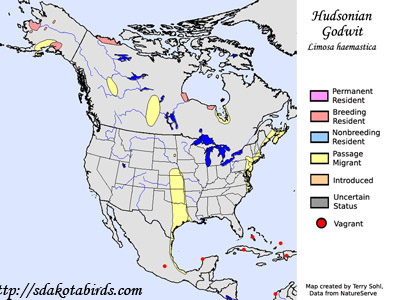 |
| South Dakota Status: Common spring migrant in the eastern part of the state, only a casual migrant in the fall. Accidental migrant in the western part of the state. |
Additional Hudsonian Godwit Photos
Click for a higher-resolution version of these photos
